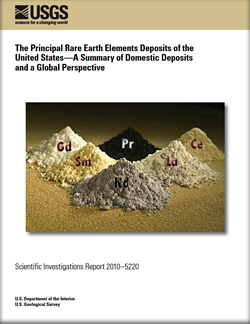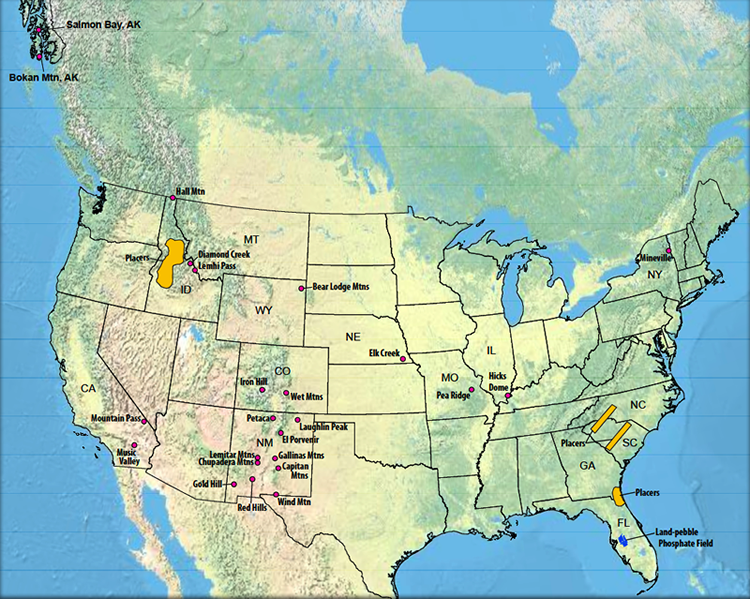Scientific Investigations Report 2010–5220

The rare earth elements (REE) are fifteen elements with atomic numbers 57 through 71, from lanthanum to lutetium (“lanthanides”), plus yttrium (39), which is chemically similar to the lanthanide elements and thus typically included with the rare earth elements. Although industrial demand for these elements is relatively small in tonnage terms, they are essential for a diverse and expanding array of high-technology applications. REE-containing magnets, metal alloys for batteries and light-weight structures, and phosphors are essential for many current and emerging alternative energy technologies, such as electric vehicles, energy-efficient lighting, and wind power. REE are also critical for a number of key defense systems and other advanced materials. Section 843 of the National Defense Authorization Act for Fiscal Year 2010, Public Law 111-84, directs the Comptroller General to complete a report on REE materials in the defense supply chain. The Office of Industrial Policy, in collaboration with other U.S. Government agencies, has initiated (in addition to this report) a detailed study of REE. This latter study will assess the Department of Defense’s use of REE, as well as the status and security of domestic and global supply chains. That study will also address vulnerabilities in the supply chain and recommend ways to mitigate any potential risks of supply disruption. To help conduct this study, the Office of Industrial Policy asked the U.S. Geological Survey (USGS) to report on domestic REE reserves and resources in a global context. To this end, the enclosed report is the initial USGS contribution to assessing and summarizing the domestic REE resources in a global perspective. In 2009, the Mineral Resources Program of the USGS organized a new project under the title Minerals at Risk and For Emerging Technologies in order to evaluate mineral resource and supply issues of rare metals that are of increasing importance to the national economy. Leaders and members of this project, with the assistance of the USGS National Minerals Information Center, prepared the enclosed USGS report on domestic REE resources. The USGS Mineral Resources Program has investigated domestic and selected foreign REE resources for many decades, and this report summarizes what has been learned from this research. The USGS National Minerals Information Center (formerly Minerals Information Team) has monitored global production, trade, and resources for an equally long period and is the principal source of statistics used in this report. The objective of this study is to provide a nontechnical overview of domestic reserves and resources of REE and possibilities for utilizing those resources. At the present time, the United States obtains its REE raw materials from foreign sources, almost exclusively from China. Import dependence upon a single country raises serious issues of supply security. In a global context, domestic REE resources are modest and of uncertain value; hence, available resources in traditional trading partners (such as Canada and Australia) are of great interest for diversifying sources of supply. This report restates basic geologic facts about REE relevant to assessing security of supply, followed by a review of current United States consumption and imports of REE, current knowledge of domestic resources, and possibilities for future domestic production. Further detail follows in a deposit-by-deposit review of the most significant domestic REE deposits (see index map). Necessary steps to develop domestic resources are discussed in a separate section, leading into a review of current domestic exploration and a discussion of the value of a future national mineral resource assessment of REE. The report also includes an overview of known global REE resources and discusses the reliability of alternative foreign sources of REE. Index Map |
Posted November 16, 2010
For additional information contact: Part or all of this report is presented in Portable Document Format (PDF); the latest version of Adobe Reader or similar software is required to view it. Download the latest version of Adobe Reader, free of charge. |
Long, K.R., Van Gosen, B.S., Foley, N.K., and Cordier, Daniel, 2010, The principal rare earth elements deposits of the United States—A summary of domestic deposits and a global perspective: U.S. Geological Survey Scientific Investigations Report 2010–5220, 96 p. Available at http://pubs.usgs.gov/sir/2010/5220/.
Introduction and Background
The Rare Earth Elements
Basic Geology of Rare Earth Elements
Mineralogy of United States Deposits
References Cited
Current Sources and Domestic Reserves
Concentration of Supply
Risk of Supply Interruption
Domestic and World Resources
Developing Rare Earth Elements Resources
Developing a Rare Earth Elements Mine
Summary
References Cited
Principal Rare Earth Elements Deposits of the United States
Glossary of Terms
References Cited
Alaska— Bokan Mountain
Salmon Bay
California— Mountain Pass Deposit and Mine
Music Valley Area
Colorado— Iron Hill Carbonatite Complex
Wet Mountains Area
Idaho— Diamond Creek Area
Hall Mountain
Lemhi Pass district, Idaho–Montana
Illinois— Hicks Dome
Missouri— Pea Ridge Iron Deposit and Mine
Nebraska— Elk Creek Carbonatite
New Mexico— Capitan Mountains
El Porvenir District
Gallinas Mountains
Gold Hill Area and White Signal District
Laughlin Peak Area
Lemitar and Chupadera Mountains
Petaca District
Red Hills Area
Wind Mountain, Cornudas Mountains
New York— Mineville Iron District
Wyoming— Bear Lodge Mountains
Phosphorite Deposits in the Southeastern United States
Placer Rare Earth Elements Deposits
Idaho—Placer Deposits
North and South Carolina—Placer Deposits
Florida and Georgia—Beach Placer Deposits